Secret Chinese menu
Hop Woo, Chinatown L.A.
In the new vernacular, sitting down for a meal at a Chinese restaurant and having your chopsticks automatically replaced with a fork is referred to as being “whited”. Of course, one could argue that the waiter’s assumption of your eating utensil of choice is minor when you peel back the proverbial onion and discover that a considerable amount of Chinese restaurants have alternate menus: the Chinese menu, and the “secret” menu. I recently had the opportunity of joining food personality Eddie Lin on a fact-finding mission to Los Angeles’ Hop Woo restaurant in Chinatown to dive beneath the pages of the English language menu and discover the secret pleasures of the Chinese and secret menus. The Chinese menu is just that – a small, Little Black Book of Chinese cuisine printed completely in that language. Chef Liang was kind enough to read items from the menu and present some of the more exotic entries in their naked glory. The evening began with a platter of BBQ chicken feet of Himalayan proportions (somewhere a genius entrepreneur is making a fortune selling avian wheelchairs). I’m not sure these were on the Chinese menu – they seemed to be a conversation starter. While not as tender as the dim sum variety (phoenix talons), they made up for the labor required to extricate the meat in flavor – they were lightly coated in a delicious sauce and tossed with peanuts, black beans, green onions and chopped chilis.
Chef Liang described the dishes in a variety of languages – in Cantonese with Eddie, in Mandarin with Mary (his friend and translator who joined us for dinner) and in Spanish with Claudia (a language he mastered while working in Mexico). I felt as if I needed the ear buds used by representatives of the United Nations for translation, but there was enough English being bandied about for me to understand what was going on. The meat in the first dish was described as “anteater”; Eddie surmised this to be aardvark (having watched one too many Pink Panther cartoons) but when a bit of shell was visible in a ladle of the soup presented it became apparent that the insectivore in question was in fact a nine-banded armadillo (yes sir, we were fixin’ to eat Texas Speedbump Soup). As with many of the dishes presented that evening, the armadillo soup is said to have healing properties – it is reputed to benefit the kidneys and lower back. Finding the edible armadillo meat was a challenge since the dark, earthy broth hid chunks of pork as well – in this dish, armadillo was “the other white meat”. Menu Item #2 looked like pasta rosettes but turned out to be goose intestines. These were cleaned remarkably well (the nose never lies) and mixed with three kinds of mushroom (drumstick, straw and shitake) taking on their woodsy flavor.
Prior to Menu Item #3’s grand debut, Chef Liang brought out a dish of one of the ingredients that looked like some kind of aquatic insect larvae or a bad toupee being soaked but turned out to be bacteria referred to as “hair vegetable”. Nostoc flagelliforme (try asking for that at your friendly neighborhood farmer’s market) is green when it is “fresh” but turns black when dried prior to being reconstituted in water. Since the Cantonese name (faat choy) is similar sounding to the phrase for “good fortune”, it is a popular ingredient in dishes eaten during Lunar New Year. The hair vegetable was only one of the components of the next dish, which featured oysters that had been dried three times in the sun prior to cooking. The mound of oysters were sitting atop chunks of pork, capped with a large mushroom button and covered in a rich brown sauce, and although the hair vegetable didn’t offer a great deal of flavor, it dissolved delightfully on the tongue. Prior to Menu Item #4’s arrival, there was much international discussion about kneecaps which was lost on me until a disk of crispy fried chicken knees were placed on the table. It only stands to reason that if you’re robbing Chicken Little of his mobility by lopping off his feet you might as well kneecap him while you’re down there. These crunchy bites were pretty tasty – I’ve sometimes chewed the cartilage off the joints in a chicken leg, but Chef Liang made the amount of work required negligible and created a tasty snack in the process.
Deer meat is said to have properties that benefit blood circulation and clear complexion, but I never have to be sold on chowing down on the Bambi platter. The odd thing about Menu Item #5 was that cooked with leeks and an unusual cucumber-like vegetable called star melon, the deer mellowed out, losing its sometimes wild flavor. The flesh was tender and moist and was by far the best venison dish I’ve eaten to date. I’m not sure Claudia was paying attention when the final item from the Chinese menu was brought out – she placed one of the small, brown disks in her mouth and said it didn’t taste much like lamb to her until I illustrated that she had never had that part of the male lamb before. I’ve had “lamb fries” at Cattlemen’s Steak House in Fort Worth previously and found them to have a tofu-like, spongy consistency that I didn’t much are for, but Chef Liang’s preparation was delicious and had a firm, rich texture. There were two sizes of the medallions with a slight variation in color; Chef Liang explained that this was due to the age difference in the donors.
We ended the meal with a medicinal soup meant to aid in digestion; it contained various roots and tubers and big chunks of what tasted like a cross between yucca root and a cord of firewood. We didn’t sample any items from the secret menu since it’s printed in Chef Liang’s head – the secret menu is whatever you request that they happen to have the ingredients for on hand. In fact, if you request something that they can’t make on the spot, Chef Liang will let you know when he can get the ingredients and invite you back to enjoy your fantasy meal. I never cease to be amazed at the unusual dishes at Hop Woo, and I’m sure many other Chinese restaurants have similar items that aren’t on the Bubba menu. One thing is certain – when I sit down for my next meal at a Chinese restaurant I will muster my best polite smile and say, “Cobra, please”. Ancient Chinese secret, huh?
Hop Woo
845 N. Broadway Blvd.
Los Angeles, CA 90012
GPS Coordinates: 34°3’48.88″N 118°14’16.05″W
GALLERY: See images from Val’s secret Chinese menu adventure at Hop Woo
Listen to Madeline Brand of KPCC with Eddie Lin experiencing the secret menu at Hop Woo
NOTE: This cost for this meal was provided by the restaurant. The content provided in this article was not influenced whatsoever by the organizer of the event

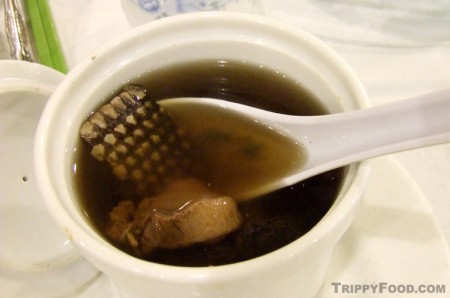
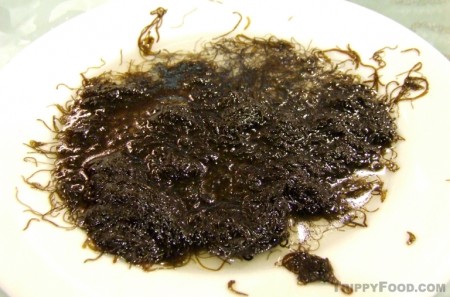
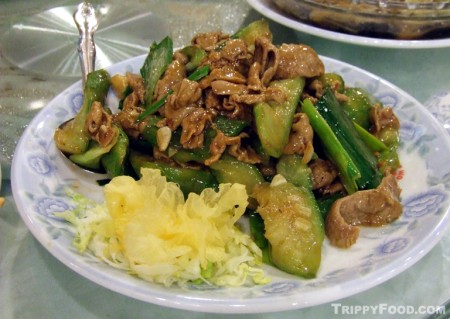
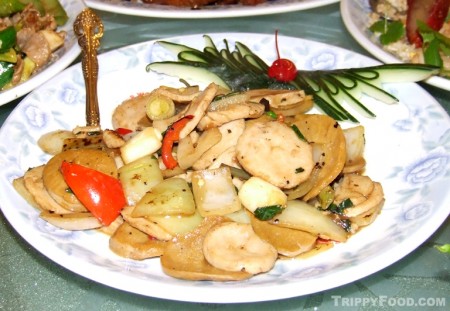
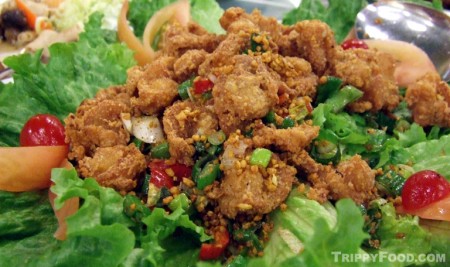

“Ancient Chinese secret, huh?” You so cwazy!
http://www.youtube.com/watch?v=ZjNRXfRXnoc
Yep, I can’t get anything past you, my friend. Of course you were in diapers when that commercial came out…
I’m almost certain Chef Lupe was speaking to Eddie in Mandarin since he spoke to me in Cantonese and told me to translate it back to Eddie (who speaks Mandarin).
I’m surprised Eddie missed that – Eddie, you want to chime in?